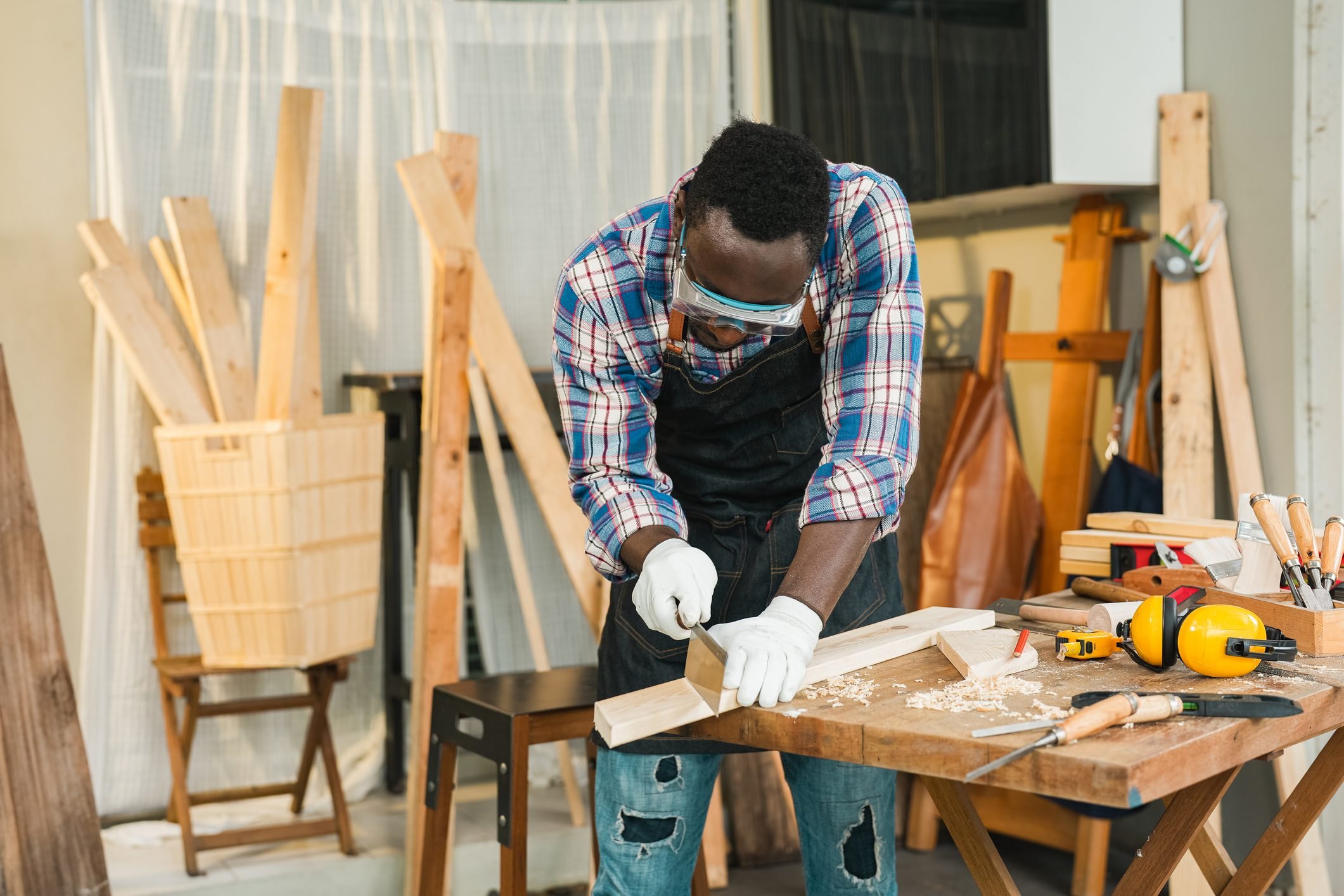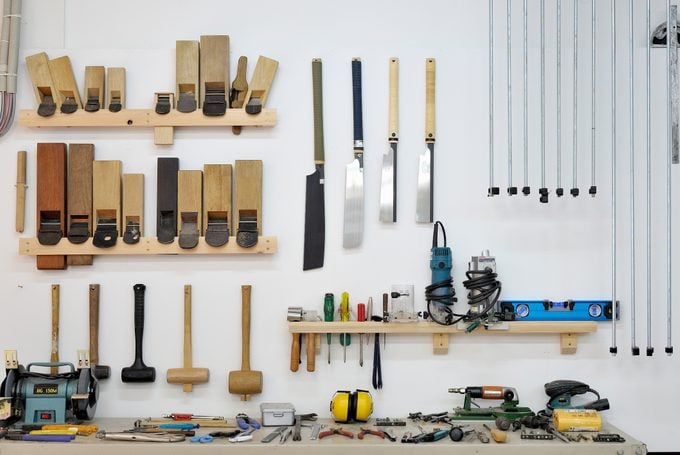Woodworking can be a relaxing and fulfilling activity that turns into a lifelong hobby for many people. Here's what you need to know to get started.

Woodworking for Beginners: Everything First-Timers Need To Know

It’s hard to think of a raw material as useful and appealing as wood. Besides making boats, buildings and other structures, you can use it to fashion cabinets, chairs and all sorts of home furnishings, plus produce carvings, picture frames, inlays and other artistic pieces. Working with wood can be an enjoyable and fulfilling activity all by itself.
Cutting, shaping and joining techniques have evolved over the years, especially since the advent of power tools. But centuries-old methods never die, they just become more refined. People still chisel wood and cut it with handsaws. Now they have better-quality tools than their forebears, especially power tools, which are faster, cleaner and require less effort.
Woodworking is not without its hazards, though. One of the most important things a beginner needs to know is how to work safely.
On This Page
What Is Woodworking?
Woodworking is the art or craft of turning wood into decorative and useful objects. Plenty of tradespeople in the construction industry work with wood but wouldn’t consider themselves woodworkers. Three things set a woodworker apart:
- A specialized focus on wood as the medium;
- A diverse collection of cutting, shaping and joining tools;
- A shop where they work.
The shop is as important as the tools because it provides space for organizing wood projects and flat, stable surfaces for assembly.
Woodworking calls for attention to detail, patience and even devotion. It takes years of practice to achieve the skill level of a master woodworker, but don’t let that deter you. Even a novice can produce good-quality wood products and have fun doing it.
Woodworking Benefits
Whether you approach it as a hobby or a profession, woodworking has psychological, social and economic benefits. It can:
- Hone your creative skills: Woodworking lets you manifest your imagination in the real world, boosting your confidence and self-worth.
- Exercise your mind: Besides applying more math than you probably absorbed in school, you’ll use it constantly. That helps keep the mind nimble.
- Relieve stress: Woodworking is relaxing. It helps relieve anxiety and lift depression.
- Promote new friendships: Woodworkers often share shop space and form working communities.
- Save money: You don’t have to buy expensive wood furniture and accessories when you can make them yourself.
Carpentry vs. Woodworking
The difference is slight: A woodworker toils in a shop while a carpenter works primarily on construction projects. The controlled shop environment allows a woodworker to create more sophisticated products, while a carpenter constructs mostly utilitarian things.
Types of Woodworking
Woodworking is an umbrella term for various skills and activities, some construction-related and some purely artistic. They include:
- Cabinetmaking: Cabinetmakers also fabricate interior furnishings like tables and chairs, as well as specialty items like boxes. They often use complex joinery and exotic hardwoods.
- Woodcarving: Primarily an artistic activity, woodcarving is one of the more low-tech types of woodworking, Employing chisels, mallets and occasionally power tools, woodcarvers create statues and figurines, decorative molding and sometimes utilitarian objects like bowls and other vessels.
- Wood turning: Give a woodcarver a lathe — a tool that spins wood on a horizontal access — and the result is more precise and intricate shaping. Wood turners produce bowls, vases and cups, shaped legs for chairs and tables, decorative balusters and even baseball bats.
- Marquetry: Also known as wood inlay, marquetry is the art of making intricate designs from thin pieces of wood and inlaying them on other surfaces. Marquetry artists typically use a scroll saw to cut geometric and floral inlay patterns.
- Wood burning: Also known as pyrography, this art burns designs into wood with a heated object like a torch or soldering iron.
Woodworking Terms
As with any specialized activity, woodworking has its own terminology. Some of the most important terms a woodworker needs to know include:
- Warp: Fresh (green) wood can contort into various shapes when it dries out. This is called warping, and it affects the usability of the wood. Some common warps include cupping (the edges of a board rise with respect to the center), crowning (the same phenomenon seen from the opposite side of the board) and bowing (the ends of the board rise).
- Wood grain: This is the pattern formed by the wood fibers. It varies by wood species and how the board was cut from the tree. Wood grain is preferably straight, but it can be curved or circular around knots. When a circular, irregular grain pattern occurs on an entire board, it’s known as burl.
- Face, edge and end grain: Face grain is the kind along the widest part of the board. Edge grain runs along the narrowest part, and end grain is exposed on the end of a board when you cut it.
- Hardwood and softwood: Hardwood comes from deciduous trees (those that drop leaves in fall) and softwood comes from coniferous trees (evergreens with needles). Softwoods are lighter and easier to work than hardwoods, but they aren’t as durable or attractive.
Woodworking Tools

A complete woodworking shop has a variety of cutting, shaping and joining tools. But when you’re starting out, you only need a few essentials, including:
- Set square: This is essential for making accurate crosscuts and assembling pieces with square corners.
- Tape measure: This determines the length and width of wood you need to cut.
- Handsaw: Japanese saws are the best. They have finely ground teeth that cut on the pull stroke and a long handle for better control. Here, learn how to sharpen a handsaw.
- Clamps: Clamps hold work in place for accurate cutting and gluing.
- Table saw: A pro will likely have a high-powered shop saw, but all you need is a portable bench saw.
- Jigsaw. When you need to cut curves, go with a jigsaw. Later you may graduate to a bandsaw or scroll saw.
- Drill: You’ll find multiple uses for a battery-powered drill, including boring holes and driving screws. Eventually you may want a drill press for better accuracy.
- Sander: There are many types of sanders. For beginners, go with a random orbital sander.
- Palm router: This isn’t an absolute necessity. But if you want to shape edges, this tool does it fastest and cleanest.
Where To Buy Wood for Woodworking
You can buy softwoods like pine, fir, redwood and cedar, as well as domestic hardwoods like oak, maple and walnut at home improvement centers.
You’ll find a better selection at a local lumber yard, which may also stock exotic hardwoods like padauk, mahogany and tigerwood. Exotics tend to be in short supply, but if you search online you’ll probably find a supplier that will ship it for a premium price.




















